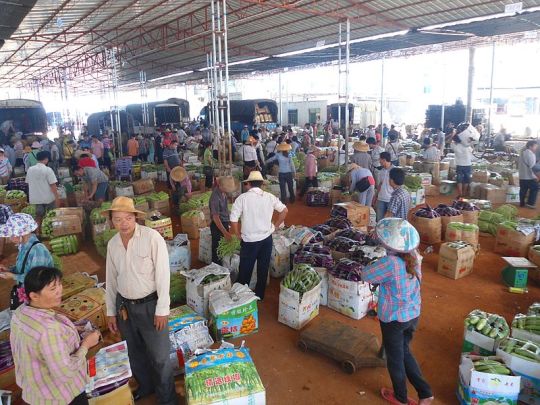#export import
Explore tagged Tumblr posts
Text
Door to Door Freight Indonesia
🚛 Door to Door Freight Indonesia | Keenam International – Hassle-Free Global Delivery 📦 From Factory to Destination – We Deliver End-to-End Need full-service delivery from your warehouse in Indonesia to your customer’s door overseas? Keenam Internationalprovides door-to-door freight services for export and import — managing everything from pickup, customs, freight transport, to final…
#Door to Door#door to door freight indonesia#end to end shipping indonesia#export import#freight forwarding jakarta#global cargo indonesia#global logistics#Indonesia Freight#jakarta cargo#legal delivery logistics
0 notes
Text
Door to Door Freight Indonesia
🚛 Door to Door Freight Indonesia | Keenam International – Hassle-Free Global Delivery 📦 From Factory to Destination – We Deliver End-to-End Need full-service delivery from your warehouse in Indonesia to your customer’s door overseas? Keenam Internationalprovides door-to-door freight services for export and import — managing everything from pickup, customs, freight transport, to final…
#Door to Door#door to door freight indonesia#end to end shipping indonesia#export import#freight forwarding jakarta#global cargo indonesia#global logistics#Indonesia Freight#jakarta cargo#legal delivery logistics
0 notes
Text
Growing Your Jaggery Export-Import Business
Jaggery, a traditional sweetener made from sugarcane or palm, has been gaining traction in global markets due to its health benefits and organic appeal. Expanding your jaggery export-import business can be a lucrative venture if approached strategically. Here’s a comprehensive guide to help you grow your business:
Understanding the Market
Market Research: Begin with thorough market research to identify key markets. Look for countries with high demand for organic and natural sweeteners. Understanding the market size, consumer preferences, and competitive landscape is crucial.
Target Audience: Identify your target audience. Are you catering to health-conscious consumers, organic food enthusiasts, or traditional sweetener users? Tailoring your marketing strategy to meet their needs will enhance your reach.
Quality and Compliance
Product Quality: Ensure that your jaggery is of the highest quality. Consumers today are well-informed and prefer products that are organic, free from chemicals, and sustainably produced.
Certifications: Obtain necessary certifications like USDA Organic, Fair Trade, and ISO. These certifications not only build trust but also open doors to international markets.
Building Strong Relationships
Supplier Network: Develop a strong network of reliable suppliers. Consistent quality and supply are vital for maintaining customer satisfaction and trust.
Customer Relationships: Foster strong relationships with your customers. Provide excellent customer service, respond to queries promptly, and address any issues efficiently.
Marketing and Branding
Brand Story: Create a compelling brand story. Highlight the traditional methods of jaggery production, its health benefits, and your commitment to quality and sustainability.
Digital Marketing: Utilize digital marketing strategies to reach a broader audience. Social media platforms, content marketing, and email campaigns can be effective tools for promoting your jaggery products.
Leveraging Technology
In today’s digital age, leveraging technology can give you a competitive edge. Volza, a revolutionary self-service app, can be an invaluable tool in this regard. It consolidates export-import trade intelligence from over 78 countries into a single subscription, providing you with access to detailed trade data and insights. This can help you:
Identify Potential Markets: Discover new and emerging markets for jaggery.
Analyze Competitors: Gain insights into your competitors' strategies and performance.
Track Trends: Stay updated on market trends and consumer preferences.
Generate Reports: Create smart, intuitive reports to make data-driven decisions.
youtube
Distribution Channels
Local Distributors: Partner with local distributors in target markets. They can help navigate local regulations, customs, and consumer preferences.
Online Platforms: List your products on popular online marketplaces. This can significantly increase your reach and accessibility to international customers.
Financial Management
Cost Management: Keep a close eye on your production and shipping costs. Optimize your processes to reduce expenses without compromising quality.
Pricing Strategy: Develop a competitive pricing strategy. Ensure that your prices reflect the quality and value of your jaggery while remaining competitive in the market.
Conclusion
Growing your jaggery export-import business requires a strategic approach, focusing on quality, market research, and leveraging technology. By incorporating tools like Volza, you can gain valuable insights and make informed decisions to drive your business forward. Embrace the digital age, build strong relationships, and maintain high standards to carve a niche in the global market for your jaggery products.
#business coaching#business consulting#business growth#business ideas#business owners#business strategy#database#exim#export#export import#Youtube
1 note
·
View note
Text
The Role of Sugar Suppliers in the USA’s Food Industry
The digital revolution has reshaped global trade dynamics, and B2B online platforms are at the forefront of this transformation. If you’re involved in the sugar export business, harnessing the power of these platforms is no longer an option—it's a necessity. In this blog, we’ll explore how to boost your Sugar Exports on B2B Online Platforms in 2023.
1. Optimize Your Online Presence
Your presence on B2B platforms matters more than ever. Ensure that your company profile is complete, professional, and up-to-date. Use high-quality images and detailed product descriptions. Highlight your unique selling points (USPs), like quality certifications, fair trade practices, and sustainable sourcing.
2. Leverage SEO Strategies
Just being present isn’t enough; you need visibility. Incorporate search engine optimization (SEO) techniques into your product listings and descriptions. Use relevant keywords that potential buyers might search for. Regularly update your content to stay current with search engine algorithms.
3. Build Trust with Reviews and Ratings
In the world of online commerce, trust is paramount. Encourage your satisfied customers to leave reviews and ratings on the platform. Positive feedback can significantly boost your credibility and attract more Buyers for Sugar Export Import Business.
4. Competitive Pricing and Discounts
In the highly competitive sugar market, pricing plays a pivotal role. Analyze your competitors’ pricing strategies and adjust yours accordingly. Consider offering discounts or promotions for bulk orders or long-term contracts.
5. Streamline Communication
Efficient and responsive communication can make or break a deal. Ensure that you respond promptly to inquiries and messages from potential buyers. Be clear and transparent about product specifications, shipping, and payment terms.
6. Embrace Technology
Stay updated with the latest technological advancements in the industry. Utilize blockchain for transparent supply chain management or explore AI-powered analytics for market insights. These tools can give you a significant edge over your competitors.
7. Participate in Trade Shows and Webinars
Online trade shows and webinars provide excellent opportunities to showcase your products and expertise. Attend and participate in these events to connect with potential buyers and industry professionals.
8. Expand Your Product Range
Diversification can be a powerful strategy. Consider expanding your product range to include sugar-related products like specialty sugars, syrups, or sugar-based ingredients. This can attract a wider range of buyers.
Conclusion
As we step into 2023, the digital age of sugar exporting is in full swing. To succeed in Sugar export import business on B2B online platforms, optimizing your online presence, embracing technology, and building trust are key. By following these strategies, you can position your sugar export business for growth and prosperity in the ever-evolving world of international trade.
0 notes
Text
"Global Trade House : Unlocking Opportunities - Import-Export Training Center Program Page"
Welcome to the program page of our import-export training center. Our carefully planned courses address everything from logistics optimization to laws governing international trade. Take part in interactive workshops, case studies, and real-world simulations under the direction of business professionals who are committed to helping you advance. Come along with us to transform your goals into reality and to start a constructive movement in the import-export industry.
0 notes
Text
How I Started an Export Import Business with No Money and Made My First Million in 1 Year

Exporting and importing goods can be a great way to grow your business and reach new markets. However, it can also be a complex process, especially if you are new to it. This article will provide you with a step-by-step guide on how to export and import goods, as well as some tips to help you succeed.
Step 1: Choose a product or service
The first step is to choose a product or service that you want to export or import. It is important to choose a product that is in demand in the target market and that you can generate a profit from. You should also consider your own expertise and resources when making your decision.
Step 2: Research the target market
Once you have chosen a product or service, you need to research the target market. This includes understanding the market size, the competitive landscape, and the regulatory requirements. You should also identify potential customers and distributors.
Step 3: Find a supplier or buyer
If you are exporting, you need to find a supplier who can provide you with the products or services that you need. If you are importing, you need to find a buyer who is willing to purchase your products or services. You can find suppliers and buyers through trade shows, online directories, and personal contacts.
Step 4: Prepare the necessary documentation
There is a variety of documentation that you need to prepare in order to export or import goods. This documentation includes commercial invoices, packing lists, and certificates of origin. You may also need to obtain special permits or licenses.
Step 5: Arrange for transportation
Once you have prepared the necessary documentation, you need to arrange for the transportation of your goods. You can ship your goods by air, sea, or land. The best mode of transportation will depend on the product or service that you are exporting or importing, as well as the cost and delivery time.
Step 6: Clear customs
Once your goods arrive at the destination country, they will need to be cleared by customs. This process can vary from country to country, but it typically involves submitting documentation and paying any applicable duties or taxes.
Tips for success
Do your research: It is important to research the target market, the competitive landscape, and the regulatory requirements before you start exporting or importing goods.
Find reliable partners: It is important to find reliable suppliers, buyers, and freight forwarders.
Be prepared for delays: There can be delays in the shipping and customs clearance process. Be prepared for these delays and have a backup plan in place.
Get professional help: If you are new to exporting or importing, it is a good idea to get professional help from a customs broker or trade consultant.
Where to buy ginger in bulk
If you are looking to buy ginger in bulk, you can do so from a variety of suppliers. Some of the most common sources of bulk ginger include:
Ginger farms: You can buy ginger directly from ginger farms. This is a good option if you are looking for a high-quality product.
Food wholesalers: Food wholesalers typically sell a variety of products, including ginger. This is a good option if you are looking for a convenient and affordable source of bulk ginger.
Online retailers: There are a number of online retailers that sell ginger in bulk. This is a good option if you are looking for a convenient and fast way to purchase ginger.
Here are some images that can enhance the content of this article:

Medium article link: https://medium.com/@exportproducts
I hope this article has been informative and helpful. If you have any further questions about exporting or importing goods, please feel free to leave a comment below.
#bussiness#export#exporter#import#importers#Export Import#How to Start an Export Import Business in 2024#The Most Profitable Export Import Products to Sell#Export Import Tips for Beginners#Export Import Success Stories#Images that can enhance the content
0 notes
Text
We have created a list of all the International Home decor expo across the globe. Hope so this will help you a lot.
0 notes
Text








starlit letter ⟡ part 2
#genshin#genshin impact#genshinedit#genshinet#kirara#lyney#lynette#freminet#neuvillette#wriothesley#charlotte#furina#m:gifs#m:*#m:gifs:all#MAKING ALL THESE GIFS WAS A GOD DAMN PAIN...............#importing/exporting everything alone nearly blew up my computer#m:1k
3K notes
·
View notes
Text
Trade Deficit/Surplus and Their Relationship to Tariffs
Hey, let’s talk about trade imbalances and why they’re not an optimal way to dictate tariffs. A few people showed interest when I asked if I should talk about it, so I've written up about [checks] 3.2k about it.
(If you want to support me in writing these up and living my best life, you can prompt me for more on ko-fi. I'm trying to move out of my parents' house.)
Previously, I explained comparative advantages and why they can be a crucial indicator for what fields are a reasonable target for import/export taxes. Let’s have a quick recap:
A comparative advantage is when two countries are both capable of an industry, but one is much better at it. Ideally, the two countries have different specialties, and can complement each other. The classic example is England, specializing in wool, and Portugal, specializing in wine. Both countries could and did engage in both industries, but they put greater amounts of resources into their specialties and then traded. If Portugal did one quarter resources on wool (to maintain a domestic industry in case of a breakdown of trade relations or natural disaster) and three quarters resources on wine, they could trade part of that wine to England for the wool, and both countries would end up with more of the product due to specialization. England has better conditions for rearing sheep, and Portugal has better weather for growing grapes.
That is comparative advantage. If two countries are largely self-sufficient, and they have one industry respectively that stands out as exceptionally efficient each, then you see a trade balance: equal amounts of wine and wool exchanged, as measured by monetary value.
An imbalance occurs when one country sells drastically more of their product than the other. Say Portugal has a bad harvest, and makes less wine than usual. They then sell less to England, but may buy the same amount of wool as usual, dipping into savings or making their money elsewhere in order to buy. In that year, England is experiencing a trade surplus, and Portugal is experiencing a trade deficit.
Four things to cover:
The nature of an enduring imbalance in a stable economic system
Artificially enforced imbalances
Indirect profits
Excluded industries
What can cause an enduring imbalance?
Let us say that we have a closed economy of three countries.
Country A has good weather and soil, and so they specialize in agriculture and are a bread basket for the region. They are self-sufficient in terms of raw minerals or metals, but have little in the way of energy resources.
Country B has a large amount of energy; they have large deposits of gas and oil, and have built out infrastructure to capture energy from offshore wind farms and hydro as well. Their farmland is decent enough to support their population, but they have little in the way of metals and minerals to build those oil drills and windmills.
Country C has a strong mining industry, and is rich in mineral resources and key metals like iron and copper. They are self-sufficient in terms of energy, but their farmland is poor and they cannot easily feed their people.
To recap:
Country A: sells food, buys energy. Little trade in mining.
Country B: sells energy, buys metals and minerals. Little trade in agriculture.
Country C: sells metals and minerals, buys food. Little trade in energy.
You can probably see where this is going: Country A sells a lot of food to Country C, but doesn’t buy metals and minerals from them, so A has a trade surplus with C. Meanwhile, they buy a lot of energy from B, which doesn’t need their food, so there they have a trade deficit there.
Country A:
Buys energy from B: deficit
Sells food to C: surplus
Country B:
Buys metals and minerals from C: deficit
Sells energy to A: surplus
Country C:
Buys food from A: deficit
Sells metals and minerals to B: surplus
As you can see, any bilateral trade relationship in this closed system is heavily imbalanced. However, when taking the full scope of the system into account, it’s balanced, because all three are feeding into each other. They cover each others’ weaknesses, and so the trade is stable.
Introducing tariffs would disrupt that balance. If A starts to tariff energy from B, because they see it as a threat to their own minimal domestic industry, then they disincentivize purchasing energy. In turn, B’s profits fall, which means they have less money to buy metals and minerals from C, which means they have fewer resources to build wind farms and oil rigs, which means they have less energy to sell in the first place. This then also impacts C, which now isn’t making as much money from selling their mining products, which means they can’t buy as much food from A, and that means… the perceived deficit, which was stable, may have been shrunk, but so has the efficiency of the entire circle.
In a global economy, there is always a good chance that the ‘deficit’ is just part of a larger balance. India buys energy from Russia, which buys food from China, which buys tropical foods from Thailand, which buys machinery from Germany, which buys electronics from Japan, which buys minerals from Australia, which buys pharmaceuticals from… India.
This is very simplified, but you see what I’m getting at with the complexity of the web of international trade. One perceived deficit does not a holistic view make.
(This is especially true of imports that are near impossible domestically. We literally can’t grow coffee in the United States outside of Hawaii and a few island territories like Puerto Rico or American Samoa. There small attempts in California and Florida, but it’s not commercially viable. Most of them cannot grow enough to export to the rest of the US, especially when factoring in other high-demand foods that require these climates, such as oranges and bananas. While there are places in the US that can grow these tropical foods, those places are so limited that we just can’t grow enough of each and every one to meet demand, so those places specialize in the foods they can grow most effectively, which is how you end up with the majority of Florida’s exports, at least in terms of cash value, being citrus, peppers, and tomatoes.)
There are valid reasons for tariffs to be implemented as protectionist measures, even when specialization seems to dictate otherwise, and I covered that in my other post. However, the above is meant to illustrate that the simplified view of trade deficits as the only dictator of tariff policy is a very poorly thought-out exercise.
Let’s look at a case study of recently-implemented tariff policies: Lesotho.
Lesotho is a small country surrounded entirely by South Africa; it’s the largest sovereign enclave in the world (the others are San Marino and Vatican City). Lesotho is a fairly poor country. They cannot afford to import much from the United States, simply due to the low GDP per capita.
For reference, the US GDP per capita is over $86k.
South Africa, Lesotho’s nearest neighbor, has a GDP per capita of about $16k, adjusted for PPP.
Lesotho’s GDP per capita, adjusted for PPP, is about $3.2k. (These numbers were pulled from Wikipedia, current as of 2023-2025.)
The people of Lesotho, by and large, cannot buy goods from the United States.
Meanwhile, they have two major lines of export. One is garment manufacturing; much like China and Southeast Asia, the low wages ensure that garment costs are kept minimal, which the people of the US find palatable. These wages to the local population are low enough that they cannot in turn buy from the US. The other export is diamonds, an industry that heavily favors the upper classes when it comes to profits, again relying on comparably low local wages that have been the subject of union actions as recently as 2020.
This article from 2017 stated that garment workers earned about $96 per month; that number has doubtlessly changed in some way since then, but it’s definitely still in the ballpark of ‘skilled workers in Lesotho make in a month what minimum-wage Americans make in two or three days.’ This study from 2022 talks about the lack of general impact of the mining industry on the population of Lesotho, addressing the employment opportunities, impact on local resources like water and air quality, and how money is or isn’t cycled back into the community.
Because of the above, Lesotho has a notable trade imbalance with the US. From the US, this is a trade deficit. The US has a very diminished capacity for garment production due to outsourcing to cheaper pastures, and only one active diamond mine, which is used for tourism rather than commercial mining. We can’t make what they do, and they can’t afford what we do.
The trade imbalance with Lesotho is 120-130 billion USD, depending on the year. They export a lot to the US, and buy very little, and I’ve hopefully illustrated why.
The tariffs laid against Lesotho, a country that cannot realistically buy much from the US due to the general poverty, were set at 50% on Trump’s so-called liberation day.
So what would that accomplish, realistically?
Artificially Enforced Trade Imbalances
We now take a look at trade imbalances that are the results of manufactured pressures rather than natural ones.
With the earlier model, I covered three countries with complementary industries and a desire to cooperate in favor of overall better outcomes. That model assumes good faith.
The real world has Walmart. Also Amazon, Apple, SHEIN, TEMU, H&M, Zara, Target, and more.
Also, a history of colonialism.
…we need to go back a bit, for this one.
For several centuries, European powers had control over large portions of the Global South and East, for a variety of reasons that mostly involved spreading diseases and having guns. The East India Companies (Dutch and English) were major factors in this.
Let’s zoom in on England and India. England had partial or full control of India from 1757 to 1947. This was achieved through superior weaponry, a navy (controlled by the East India Company) that could blockade ports, and a generally higher willingness to commit crimes against locals. Due to English control over many aspects of trade and access to resources, the economy was aggressively molded to be in greater favor of the British. This includes deindustrialization, taxes that favored British imports over domestic products, and enforced trade barriers to other nations. A particularly notable example is the cotton trade; raw cotton would be shipped to the UK with no tariff, spun into threads and woven into fabric, and then sold back to India at a high tax rate. This meant that India was pressured into sending away a central pillar of their economy, and then sold that same product back at a massively inflated cost that they had to pay, because they no longer had the resources to do it domestically. This led to a widespread reduction in the infrastructure to make fabric as they had once been known for, along with a massive transfer of wealth from India to the UK, much of it under the oversight of the British East India Company.
This had a lasting impact on India, one that they’ve been working to recover from since before gaining independence. This is true of many countries that were colonized and exploited by the West, which includes most of Latin America, Africa, South Asia, and South-East Asia. Some of East Asia can be read broadly as having recovered, but few economies managed that kind of economic bounce-back, and few did so quickly.
These days, there is no British East India Company, as it was dissolved in the 1870s. Instead, we have companies like Walmart and Amazon. Their tactics involve a few less guns, but there is still a massive impact on things like local wages.
(The guns do still make an appearance; ever heard of union-busting?)
Due to the size of the American economy, military, and political influence, smaller economies with less power are pressured to submit to Western whims. America, in particular, gained a lot of international power with WWII, setting up bases all over the world, as well as experiencing a massive economic boom. The two factors combined resulted in an economy that could buy in bulk for sales at department stores, even setting up individual factories of their own in these countries that were, in many cases, only just achieving independence from their Western colonists. They were still in the agricultural period of economic growth, often due to forced de-industrialization like in India, and the manufacturing business was created by foreign investment, or by a government inviting such from foreigners.
Newly independent, struggling economies, searching for a way to strengthen their positions and banks. Factories, and a wealthy overseas client that wants all the goods you can make.
They will pay you pennies for it. Those are pennies you don’t have, and maybe you have a debt to pay off. Maybe the government incurred debts building those factories, and people have to work to pay that off, but once it’s paid, you’ll get the money for real!
(You know those $200k student loans you spend forever working off? Imagine that, but it's your regional government owing money to a foreign company.)
Or maybe they pay you decently, for now.
So, countries with decimated industries agree to work for these companies. They get into factories, sit down, and start sewing. They agree to do petroleum refinement because the US doesn’t want to stink up its own air anymore, could you do it instead, pretty please? They mine, or cut lumber, or destroy their own rivers making that pretty ‘vegan’ leather.
And your local economy is reliant on Walmart now, or Amazon, or Apple. Ninety percent of the town works for them, after all!
But inflation is a thing, so you ask for a raise.
And the factory says no.
In fact, they cut your wages. You’re making too much, they say. The shops in America want it cheaper, they claim. Too bad, so sad. If you don’t like it, go work somewhere else.
But the factory employs 90% of the town.
So because America wants cheap goods, there is a trade deficit: buy whatever you want from China, or Bangladesh, or Vietnam. They can’t afford to buy anything back, but that doesn’t matter, does it?
Oh hey, we are sending them so much money by buying all their stuff! That’s not fair, is it? They’re taking advantage of the United States by not buying any of our products. Let’s tariff them.
Western companies placed interminable barriers on these economies, and now the US government wants to punish the victims of those barriers. And that’s frustrating for many reasons, but a big one is this:
Indirect Profits
A lot of the ‘imports’ that the US gets are actually bringing a net profit.
Let’s say Apple set up a factory in China ten or twenty years ago. They are pretty entrenched as part of the economy, and it also took a long time to establish. There is nothing in the US that can replace it in a realistic timeframe.
Let’s say that iPhone takes $400 to build in China. $150 for parts, $250 for labor and overhead, and then toss on $5 for shipping, since that’s a cost that easy to scale. Bring that phone to the US or France or Singapore, sell it for $1000. That’s almost $600 in profit!
Something that is valued at $1000 gets tariffed at the $400, and then sales taxed at the $1000.
And that profit goes toooooooooooooooo Apple.
Back in the US. Except it’s actually Ireland. (They do this to avoid other taxes.)
(The Ireland situation is insane, by the way. They call it leprechaun economics. You can read about it, though this article is much more Accounting Terminology than most people looking to read.)
Now, I do need to clarify that the Trade Imbalance Numbers are still using that wholesale rate of $400, not $1000. So it doesn’t necessarily impact the trade numbers as massively as it could, but the end numbers are that the perceived value of the trade deficit isn’t the actual end value of the products being imported.
And the thing is, that profit still gets back to the US (technically Ireland), even when that phone goes to Germany or Nicaragua or Burundi or wherever else. The American company still gets the money, which then gets spent on physical imports like mangoes and cobalt.
The US takes advantage of China in this regard, because so much of that profit is pocketed by the parent company, in the US (technically Ireland), rather than the employees themselves. The given reason for this is that the Americans are bringing the product development and coding and marketing to the table.
Phone made in China, sold to Germany. Trade imbalance reflects the relationship between China and Germany, but the profits go to the United States: the US is making money that isn't reflected in trade deficits.
And that brings us to our last point:
Excluded Industries
Did you know that the trade deficit only counts physical goods?
These numbers do not include IP or service trades.
That art your friend in the UK commissioned you to draw does not factor in. The South Korean showings of the latest Marvel movie do not factor in. That Adobe Photoshop that someone downloaded in Brazil does not factor in. That Netflix subscription in Italy doesn’t factor in. That financial analyst getting paid by a US company to report on the Nikkei index in real time, from Japan, does not factor in. That head of operations that the US company is paying to run product distribution in Dubai does not factor in. That C drama you streamed in Colorado doesn’t count. That eBook you bought from a writer in Darfur doesn’t count. That app you bought from a company in Peru doesn’t count.
None of it counts.
None of this is included in the calculations. Even the WSJ is annoyed (that article is paywalled but I like their chart at the top, and that part is free to see).
Now, the services surplus isn’t enough to compensate for the trades surplus, but it doesn’t have to be. Remember: if you make something in Vietnam, and sell it in Spain, but the money still comes back to the US… that doesn’t count towards either side of the trade balance.
But it does raise the GDP.
(Unless you send the money to Ireland, maybe.)
Trade deficits are a genuinely bad thing to base your tariff policy on, in the sense that it cannot be the only factor. It can factor in—doing so with China in particular makes sense given shifts in the global market since the early 2000s, especially with regards to de minimus exemption—but it can’t be your sole deciding factor.
This is especially true when the government both isn’t doing it for the reason they claim (likely), or doesn’t understand what tariffs and trade deficits really do (Trump, at least, has been talking about this since the 1980s, so I’m pretty sure he actually believes in this, and thus doesn’t know the actual ramifications).
Conclusion
Sometimes you need to understand how comparative advantage and trade webs work before you take someone’s word for the nature of deficits. Tariffs play a role in the balance of trade and protection of domestic industry, but trade imbalances cannot be your only factor in deciding on tariffs, nor can tariffs be your only tool in reindustrialization.
Anyway. Prompt me for more on ko-fi or something. Help me move out of my parents' house.
#tariffs#politics#economics#economics for dummies#phoenix posts#phoenix politics#trade deficit#trade surplus#trade imbalances#trade policy#trade war#exports#imports#taxes#colonialism#imperialism#india#lesotho#united states#china#industry#industrialization#reindustrialization
160 notes
·
View notes
Text






2x06 DOSED
#911abc#911abcedit#911edit#buddie#buddieedit#buddienetwork#&#my gifs#mine#buddiesource#tuserambs#useraudrey2#usernoah#tusermira#looklasagna#useralien#userbuckleys#usermadita#userrin#usercats#userarrow#usertenacious#okay so these are gonna be fun aren't they#also pretty sure my photoshop is going to leave me for the next available computer#because this took me four hours and 3.25 of those hours were just waiting for photoshop to import export and load#sounds like a reboot is in order lol
84 notes
·
View notes
Text
International Freight Forwarding
Trusted International Freight Forwarding Services Since 1993 Keenam International is a leading provider of international freight forwarding services based in Jakarta, Indonesia. Since 1993, we’ve supported companies of all sizes with global logistics solutions—offering end-to-end services that include air freight, sea freight, customs clearance, and DG (Dangerous Goods) handling. Whether you’re…
#air freight jakarta#customs clearance Indonesia#customs clearance services#DG cargo#DG cargo logistics#export import#export import support#freight forwarder Indonesia#freight forwarding Indonesia#international freight forwarding#Keenam International#sea freight Indonesia#sea freight jakarta
0 notes
Text
Export Import
Apa Itu Export Import? Export import adalah kegiatan pengiriman barang dari satu negara ke negara lain. Export (ekspor) berarti mengirim barang dari Indonesia ke luar negeri, sedangkan import (impor) adalah menerima barang dari luar negeri ke Indonesia. Untuk menjalankan proses ini secara aman, legal, dan efisien, Anda memerlukan mitra logistik resmi yang berpengalaman. Keenam…
#export import#export ke china#Freight Forwarding Indonesia#import dari usa#jasa ekspor impor resmi#jasa ekspor resmi#jasa export import#jasa impor legal#jasa logistik indonesia#pengiriman internasional
0 notes
Text
Exploring the Role of Sugar Suppliers in the USA's Food Industry
The digital revolution has reshaped global trade dynamics, and B2B online platforms are at the forefront of this transformation. If you’re involved in the sugar export business, harnessing the power of these platforms is no longer an option—it’s a necessity. In this blog, we’ll explore how to boost your Sugar Exports on B2B Online Platforms in 2023.
Optimize Your Online Presence
Your presence on B2B platforms matters more than ever. Ensure that your company profile is complete, professional, and up to date. Use high-quality images and detailed product descriptions. Highlight your unique selling points (USPs) like quality certifications, fair trade practices, and sustainable sourcing.
Leverage SEO Strategies
Just being present isn’t enough; you need visibility. Incorporate search engine optimization (SEO) techniques into your product listings and descriptions. Use relevant keywords that potential buyers might search for. Regularly update your content to stay current with search engine algorithms.
Build Trust with Reviews and Ratings
In the world of online commerce, trust is paramount. Encourage your satisfied customers to leave reviews and ratings on the platform. Positive feedback can significantly boost your credibility and attract more Buyers for Sugar Export Import Business.
Competitive Pricing and Discounts
In the highly competitive sugar market, pricing plays a pivotal role. Analyze your competitors’ pricing strategies and adjust yours accordingly. Consider offering discounts or promotions for bulk orders or long-term contracts.
Streamline Communication
Efficient and responsive communication can make or break a deal. Ensure that you respond promptly to inquiries and messages from potential buyers. Be clear and transparent about product specifications, shipping, and payment terms.
Embrace Technology
Stay updated with the latest technological advancements in the industry. Utilize blockchain for transparent supply chain management or explore AI-powered analytics for market insights. These tools can give you a significant edge over competitors.
Participate in Trade Shows and Webinars
Online trade shows and webinars provide excellent opportunities to showcase your products and expertise. Attend and participate in these events to connect with potential buyers and industry professionals.
Expand Your Product Range
Diversification can be a powerful strategy. Consider expanding your product range to include sugar-related products like specialty sugars, syrups, or sugar-based ingredients. This can attract a wider range of buyers.
Conclusion
As we step into 2023, the digital age of sugar exporting is in full swing. To succeed in Sugar export import business on B2B online platforms, optimizing your online presence, embracing technology, and building trust are key. By following these strategies, you can position your sugar export business for growth and prosperity in the ever-evolving world of international trade.
0 notes
Text
0 notes
Text
Global Trade House, established in 2011, offers quality international business training to young and small, medium, and large enterprises to enhance their global business operations.
Over 5000 people have successfully become exporters and importers through import export courses. The institute aims to train entrepreneurs in international trade business, enabling them to catalyze demand and supply, gain employment, and connect businesses on international platforms. The courses are available online and offline.

0 notes